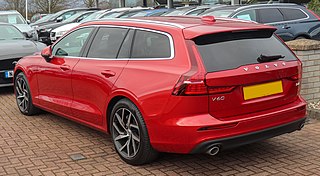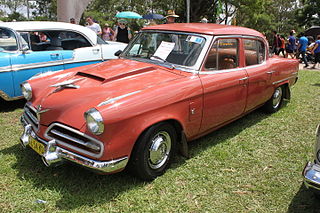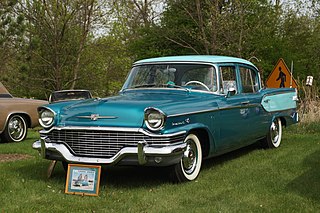
A station wagon or estate car, is an automotive body-style variant of a sedan/saloon with its roof extended rearward over a shared passenger/cargo volume with access at the back via a third or fifth door, instead of a trunk/boot lid. The body style transforms a standard three-box design into a two-box design — to include an A, B, and C-pillar, as well as a D-pillar. Station wagons can flexibly reconfigure their interior volume via fold-down rear seats to prioritize either passenger or cargo volume.

Packard was an American luxury automobile marque built by the Packard Motor Car Company of Detroit, Michigan, United States. The first Packard automobiles were produced in 1899, and the last Detroit-built Packard in 1956, when they built the Packard Predictor, their last concept car.

Studebaker was an American wagon and automobile manufacturer based in South Bend, Indiana. Founded in 1852 and incorporated in 1868 as the Studebaker Brothers Manufacturing Company, the firm was originally a coachbuilder, manufacturing wagons, buggies, carriages and harnesses.
The 1957 and 1958Packard lineup of automobiles were based on Studebaker models: restyled, rebadged, and given more luxurious interiors. After 1956 production, the Packard engine and transmission factory was leased to the Curtiss-Wright Corporation while the assembly plant on Detroit's East Grand Boulevard was sold, ending the line of Packard-built cars. However, Studebaker-Packard executives hoped to keep the Packard name alive until a fully restyled model could be funded, developed, and produced. These cars were built in hopes that enough would be sold to enable the company to design and build a completely new luxury Packard.

The Studebaker Land Cruiser is an automobile that was produced by the Studebaker Corporation of South Bend, Indiana from 1934-1954. The Land Cruiser debuted at the World's Fair alongside the Silver Arrow, a product of Studebaker's former premium make Pierce-Arrow. It was also manufactured in Vernon, California.

The Studebaker Commander is the model name of several automobiles produced by the Studebaker Corporation of South Bend, Indiana and Studebaker of Canada Ltd of Walkerville and, later, Hamilton, Ontario (Canada). Studebaker began using the Commander name in 1927 and continued to use it until 1964, with the exception of 1936 and 1959-63. The name was applied to various products in the company's line-up from year to year. The Commander was the company's mainstream product, the Studebaker Champion was the junior model, and other models were short lived or renamed as market conditions required.

The Studebaker Champion is an automobile which was produced by the Studebaker Corporation of South Bend, Indiana, from the beginning of the 1939 model year until 1958. It was a full-size car in its first three generations and a mid-size car in its fourth and fifth generation models, serving as the junior model to the Commander.

The Studebaker Wagonaire was a station wagon produced by the Studebaker Corporation of South Bend, Indiana, from 1963–1966. It featured a retractable sliding rear roof section that allowed the vehicle to carry items that would otherwise be too tall for a conventional station wagon of the era.

The Studebaker Lark is a compact car that was produced by Studebaker from 1959 to 1966.

The Scotsman is an automobile series that was produced by the Studebaker Packard Corporation of South Bend, Indiana, during model years 1957 and 1958, and a low-priced series of pickup trucks in 1958 and 1959. The name was based on the reputation of Scottish frugality, the cars being built for function and minimalism.

Plymouth Belvedere is a series of American automobile models made by Plymouth from 1954 to 1970. The Belvedere name was first used for a new hardtop body style in the Plymouth Cranbrook line for the 1951 model year. In 1954 the Belvedere replaced the Cranbrook as the top trim and became a full model line with sedans, station wagons and convertible body styles. The Belvedere continued as Plymouth's full-sized car until 1965, when it became an intermediate, and was replaced after the 1970 model year by the Satellite, a name originally used for the top-trim level Belvederes. The nameplate "belvedere" is Italian for "beautiful sight" or “fair view”. Chrysler also had the Belvidere Assembly Plant in Belvidere, Illinois which began production in 1965.

The Studebaker President was the premier automobile model manufactured by the Studebaker Corporation of South Bend, Indiana (US) from 1926-1942. The nameplate was reintroduced in 1955 and used until the end of the 1958 model when the name was retired.

The Starlight coupe is a unique 2-door body style that was offered by Studebaker Corporation of South Bend, Indiana from 1947 to 1955 on its Champion and Commander model series. It was designed by Virgil Exner, formerly of Raymond Loewy Associates.

The Plymouth Savoy is an automobile model produced from the 1954 through 1964 model years by Plymouth.

The Packard Clipper is an automobile which was built by the Packard Motor Car Company for models years 1941–1942, 1946–1947 and 1953–1957. For 1956 only, Clipper was classified as a stand-alone marque. The Clipper was introduced in April, 1941, as a mid-model year entry. It was available only as a four-door sedan. The Clipper name was reintroduced in 1953, for the automaker's lowest-priced lineup. By 1955, the Clipper models were seen as diluting Packard's marketing as a luxury automobile marque. It was named for a type of sailing ship, called a clipper.
The Packard Patrician is an automobile which was built by the Packard Motor Car Company of Detroit, Michigan, from model years 1951 through the 1956. During its six years in production, the Patrician was built in Packard's Detroit facilities on East Grand Boulevard. The word "patrician" is Latin for a ruling class in Ancient Rome.

The Ford Falcon is a model line of cars that was produced by Ford from the 1960 to 1970 model years. The first compact car marketed by the American Big Three automobile manufacturers, the Falcon was the third car line introduced by Ford, following the full-sized Ford and the Ford Thunderbird.

The Willys Jeep Station Wagon, Jeep Utility Wagon and Jeep Panel Delivery are automobiles produced by Willys and Kaiser Jeep in the United States from 1946 to 1964, with production in Argentina and Brazil continuing until 1970 and 1977 respectively. They were the first mass-market all-steel station wagons designed and built as a passenger vehicle.

The E series Studebaker trucks are the original 1955 E series Studebaker trucks, sold in half-ton, 3/4-ton, and 1-, 1.5-, and 2-ton capacities, and the1956: 2E series; 1957-58: 3E series; 1959: 4E series; 1960: 5E series; 1961: 6E series; 1962: 7E series; and 1963-64: 8E series. Given these model-year designations, "E series" has come to mean all Studebaker trucks built between 1955 and the end of all vehicle production in the US in December 1963. Within each tonnage rating, these trucks were all fairly similar, since Studebaker was in dire financial straits during this entire period and invested virtually nothing to update its truck division products. For the 1956 and 1957-58 models, all Studebaker trucks were called Transtar.






















